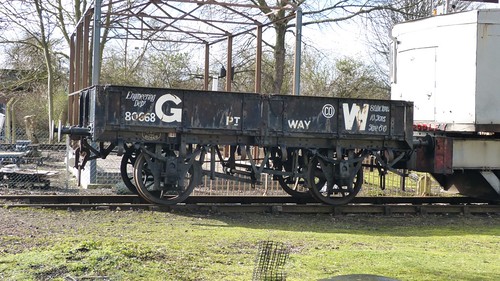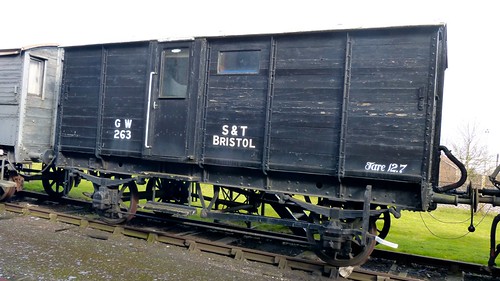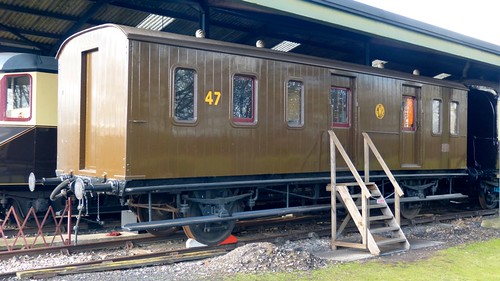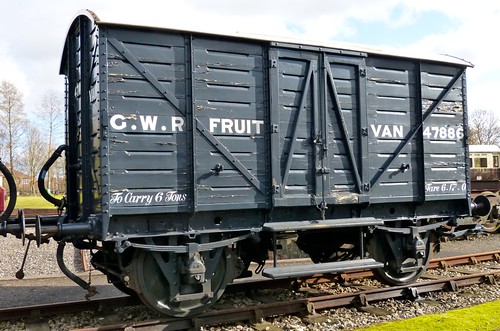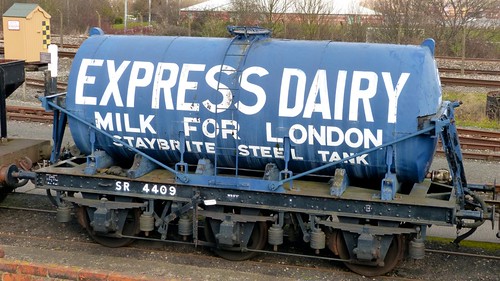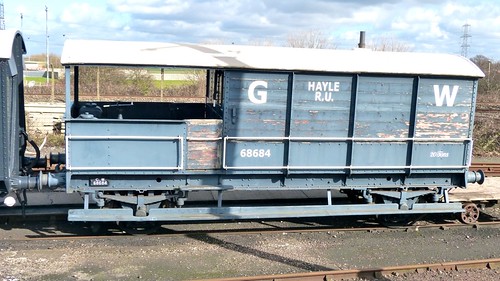A day out to Oxford mainly to see the buses (see elsewhere on my blog) also afforded me the time to catch the train from Oxford to Didcot where the ‘GWS’ are based.
Although it was not a running day, there was plenty to interest me and from the assorted wagons on display, I have been able to make up a couple of typically ‘Great Western Railway’ (GWR) trains that will appear in later ‘blogs’.
Where vehicles have been restored, the standard is excellent and work is ongoing to restore many others.
The GWS site stands at the side of Didcot railway station and the sound of trains passing by on the main lines is a constant accompaniment.
Access is via an underpass from the mainline railway station and the site itself is spacious and well set out.
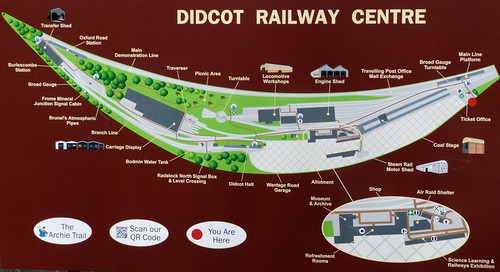
The coaling stage with the water tank on top dominates the 1930‘s built loco sheds seen to the right.

Loco No. 5227
A Great Western Railway (GWR) 2-8-0T of the 5203 class built at Swindon in 1924.
They were built for hauling coal trains from the South Wales coalfield over relatively short distances.
The loco was has been used to supply parts for the building of a class 47XX No 4709 freight loco at Didcot.
What is left is displayed to represent loco’s that were in Woodhams scrapyard at Barry.

Loco No. 6697
An 0-6 2T loco of the ‘GWR’ 56XX class built by Armstrong Whitworth & Co. at Newcastle in 1928.
This class of 200 loco’s were urgently needed to replace worn out machines taken over from the absorbed railways of South Wales. This led to the use of outside contractors, an unusual move for the ‘GWR’.
Sold into preservation in 1966 from Wrexham depot the loco came to Didcot in 1970, was restored cosmetically and is now on static display.

Loco No. 18000
A gas turbine- electric loco (gte) was ordered by the ‘GWR’ in 1946 and delivered to
‘British Railways’ in 1949. It was built by Brown Boveri and SLM in Switzerland.
The ‘GWR’ chose the ‘gte’ because at that time there was no single unit diesel electric that could haul what the ‘GWR’ King class loco could.
In service it proved troublesome and expensive to operate so was withdrawn in 1960. Returned to Switzerland, it was used in wheel to rail experiments. In 1975 it was displayed in Vienna. It was returned to the UK in the early 1990’s and was stored at Crewe. It spent some time on the Gloucester Warwickshire Railway as a static exhibit before coming to Didcot in 2011.

Loco DL 26 named ‘The Rat’.
Built in 1957 by the Hunslet Engine Co. of Leeds. A lightwieght loco it is used for moving stock over the carriage shed traverser (see later).
British Railways (BR) class 05 was a very close relative and although this loco carries a ‘BR’ totem it is in fact a loco produced for an industrial customer.

Loco 08604 named ‘Phantom’.
Although it carries ‘GWR’ style number and nameplates it is a standard ‘BR’ 08 class shunter.
Built originally as D3771 at Derby, one of a class of 996. Shedded for many years at Tyseley, Birmingham it has been at Didcot since 1984.

Diesel Railcar No.22
Built by the ‘GWR’ at Swindon in 1940/41to diagram A1. Powered by 2 AEC 105 HP engines this and its classmates were the forerunners of the mass introduction of Diesel Multiple Units that were to be produced in the early 1960’s at about the time that No. 22 was withdrawn.

No.190 Autcoach
Belonging to an earlier generation of passenger transport is this ‘GWR’ coach built at Swindon in 1933 to diagram A.30. Being non powered, they always worked with a loco in push-pull mode, the loco normally being a tank.
A driving cab was fitted at the one end whilst the loco end is without windows.
No. 190 has been in preservation since 1970. The interior has been refurbished but the unit only operates on high days and holidays.

The sheds that hold the coaching stock at Didcot are accessed by a traverser. The little red/cream ‘cabin’ is effectively a loco that pushes or pulls the bridging deck to line up with the vehicle required which is then extracted and placed elsewhere.
A clever device that saves a lot of points and trackwork in a limited space.

There are a couple of direct links to Isambard Kingdom Brunel (IKB) at Didcot. The first of which is this remnant of pipework from ‘IKB’s unsuccesful ‘Atmospheric Railway’ (AR) in South Devon.
The story of the ’AR’ is far to lengthy and complex to be covered in detail here however it is a fascinating story and is well worth further investigation should you be so minded.
This piece of original pipework is seen set between a section of broad gauge track.
After the failure of the ‘AR’ the hardware was disposed of. The section seen below was recovered from a site at Goodrington Sands near Paignton. It had been used for land drainage. The smaller sections that make up this pipe were discovered in 1993 by the South West Group of the ‘GWS’.
The other link to ‘IKB’ is to the ‘Broad Gauge’ (BG) itself. ‘IKB’ was of the opinion that a track gauge of seven feet would produce a more stable and a higher speed line. Indeed many hundreds of miles on the ‘GWR’ were so built before it was decreed that Stephenson’s gauge of four feet eight and a half inches became the Standard Gauge (SG).
Didcot has a short stretch of ‘BG’ Track and here we see it interlaced with ‘SG’ track to produce a dual gauge point.

‘BG’ and ‘SG’ track side by side.

A replica of a ‘GWR’ ‘BG’ loco named ‘Firefly’ stands in an adjacent shed when it is not in operation. Its construction took over 20 years entering service at Didcot in 2005.
The original loco of was designed by Daniel Gooch in 1840 as a 2-2-2 and it ran in service until 1870.

I think that Brunel’s original conception of the Broad Gauge was probably right in that it would have produced a more comfortable ride than the Standard Gauge.
The whole railway would have been bigger and more spacious. Just how much that would add to the cost of today’s HS2 ? I dread to think.







